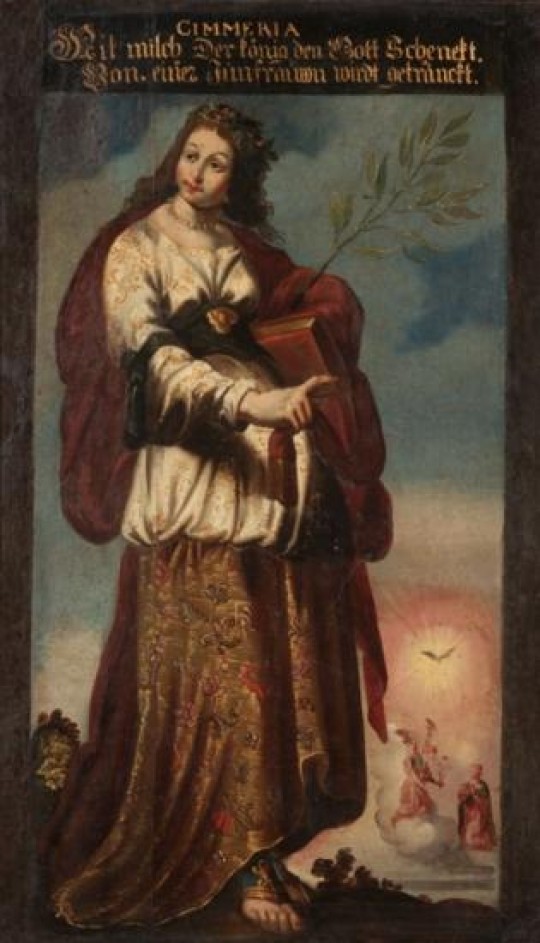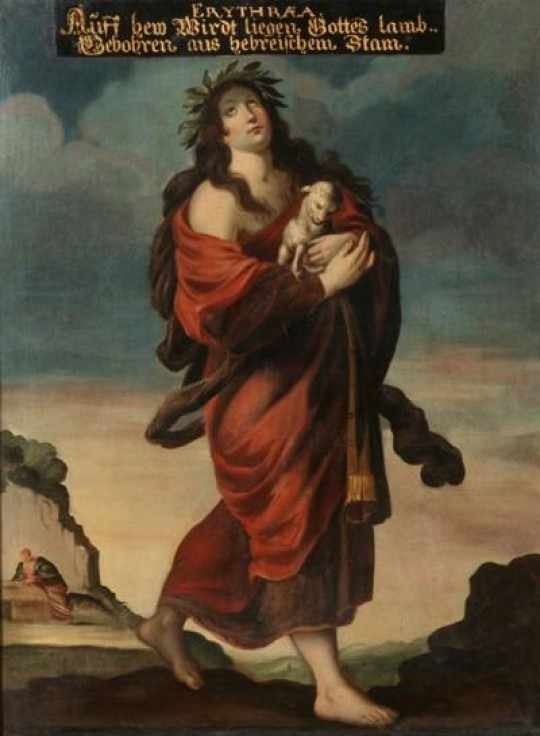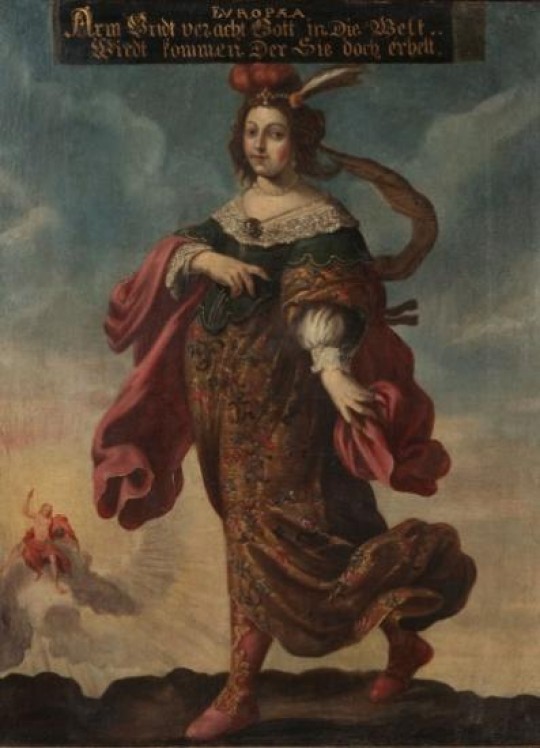The Town Hall of the Old Town Hall is decorated with a cycle of twelve Sibyls, coming from the chapel of the Fichtl house at Podwale Staromiejskie 69/70 Street. In ancient times, Sibyls were considered harbingers of unfortunate events, such as the Trojan War or the Persian Wars. In the first centuries AD, they were considered heralds of the Apocalypse, and due to the announcements of the coming of Christ and subsequent events in his life attributed to them, they became the equivalent of the Old Testament prophets.
The Gdańsk series of Sybils has a didactic and moralizing character, it addresses issues of salvation and faith in the context of apocalyptic moods prevailing in the second half of the 17th century. By placing verse texts within the composition, the images acquired the character of an emblem consisting of three elements: icon - the image of Sibyl, explicatio - a scene in the background regarding the life of Christ and Mary, and the lemma, which is a couplet related to the prophecy. Emblematic paintings, carrying important didactic content through the authority of the Bible, were very popular in Gdańsk, especially in the mid-17th century.
The authorship of the undated paintings in the Town Hall is attributed to Adolf Boy (1612-1680), one of the most valued Gdańsk masters of the mid-17th century. The Town Hall Sibyls had a graphic prototype - copperplate engravings by Gilles Rousselet based on drawings by Claude Vignon. The Gdańsk artist precisely repeated the poses, gestures, and arrangement of the clothes of the main characters, as well as the scenes in the background and parts of the sky and clouds. He treated the details of clothes a little more freely, enriching them with exquisite ornaments and jewelry, in line with the fashion currently in force in the city on the Motława River. Sybill's decorative nature reveals the artist's passion for detail, already evident in his early watercolors. The pictures are painted with flat spots of color without subtle tonal transitions, the planes modeled in black or white are clearly defined by contour. Color solutions - combinations of warm colors in the foreground and cool blues in the background, belong to the repertoire of Mannerist painting. The Gdańsk Sibyls are provided with couplets in German in the upper part of the composition, referring to the prophecies they preach. The order of the images is determined by the following scenes from the life of Christ placed in the background:
1. Cimmeria, Sibyl of Cimmeria.
In the background on the right there is a scene of the Annunciation, the inscription reads:
Mit milch Der könig den Gott Schenckt,
Von einer Jungfrauen wirdt getränckt.
The king that God offered
He will be given milk by the Virgin.
2. Tiburtina, Sybil of Tiburtina.
In the background there is a Christmas scene, above there is an inscription:
Zu Bethleem ein Stern Auf geht.
Undt wirdt gerhumbt Zu Nazareth.
A star is rising in Bethlehem
And he is celebrated in Nazareth.
3. Erythraea, Sybil of Erythraea.
In the background there is a scene of the Feeding of the Child, the text of the inscription:
Auff hew Wirdt liegen Gottes Lamb.
Gebohren aus hebreischem Stam.
The Lamb of God will lie on the hay
Born of the Hebrew tribe.
4. Persica, Sybil of Persian and Mary with the Child trampling on a serpent.
Der Heiden heil Der Seelen hirt.
Der Schlangen kopff Zertreten wirt.
Savior of the pagans and shepherd of souls
He will trample on the head of the serpent.
5. Delfica, Sybil of Delfica.
On the left there is a bell, on the right - Adoration of the Magi. The scene is complemented by an inscription:
Ein Stern Der heiden Volck her lenckt.
Das ihm gold Weirauch mirrhen schenckt.
The star that guides the pagan people here
He gives Him gold, frankincense and myrrh.
6. Hellespontica, Sybil of Hellespontica.
In the background - the scene of the Presentation in the Temple. The inscription reads:
Von Judischen Geblut ein Held.
Das heil wirdt bringen aller Welt.
A hero from the Judean family
He will bring salvation to the whole world.
7. Agrippa, Sybil of Agrippa.
Christ illuminates the sky with radiant glory, above the words of prophecy:
Der Gottes Sohn ist undt Selbest Gott.
Wirdt leiden Armut hohn Und Spott.
He who is the Son of God is himself God
He will suffer poverty, scorn and ridicule.
8. Samia, Sybil of Samia.
In the background there is a scene of the Crucifixion, the text of the inscription:
Du Jud hast Den der uns heil Schenckt
Mit dorn gekrönt Bundt gall Getränckt.
You Jew: you hate the one who offers you salvation,
Crowned with thorns, wounded, filled with bile.
9. Libyca, Sybil of Libia.
In the background, Descent into the Abyss, a verse inscription reads:
Das lebens könig Mit Der Handt,
Zerreissen Wirdt des todes bandt.
The king of life will tear it apart with his hand
Chains of death.
10. Cumana, Sybil of Cumana and Resurrection.
Inscription:
Die Jungfrau kömpt ihr Sohn aufteht,
Der krieg Hört auff Der Fried angeht.
The Virgin comes, her Son rises,
The war ends, peace comes.
11. Europaea, Sybil of Europe and Salvator Mundi.
Prophecy news:
Arm undt verach Gott in die Welt,
Wirdt kommen Der Sie doch erhelt.
A poor and despised God will come into the world,
But it will enlighten him nonetheless.
12. Phrygia, Sybil of Phrygia and The Last Judgement.
Versed prophecy:
Das heer Horn Schallet in der lufft,
Und vor Gericht Die Welt beruff.
The horn of the Lord will sound in the air
And he will call the world to judgment.
(Translation of the inscription: Renata Słoma, Sybille, Kraków 2000) Works of art included in the furnishings of the private chapel of the Fichtl family's house at ul. Podwale Staromiejskie 69/70 were moved to the Old Town Hall in 1914; ceiling, wainscoting and fireplace were placed in the Mayor's Room. At the same time, the hall on the first floor was decorated with a ceiling lamp from the tenement house at ul. Długa 39. 17th-century works of Gdańsk art, removed from the buildings that were being modernized at that time, were moved to the Town Hall after its reconstruction in 1911-1914. The interior layout of the Old Town Hall and their arrangement are the result of the work of conservators. Thanks to the revitalization at that time, the first-floor Hall, the Mayor's Room and the Town Hall became, next to the Gdańsk Hall, a priceless document of the appearance of the baroque bourgeois interior in Gdańsk.












